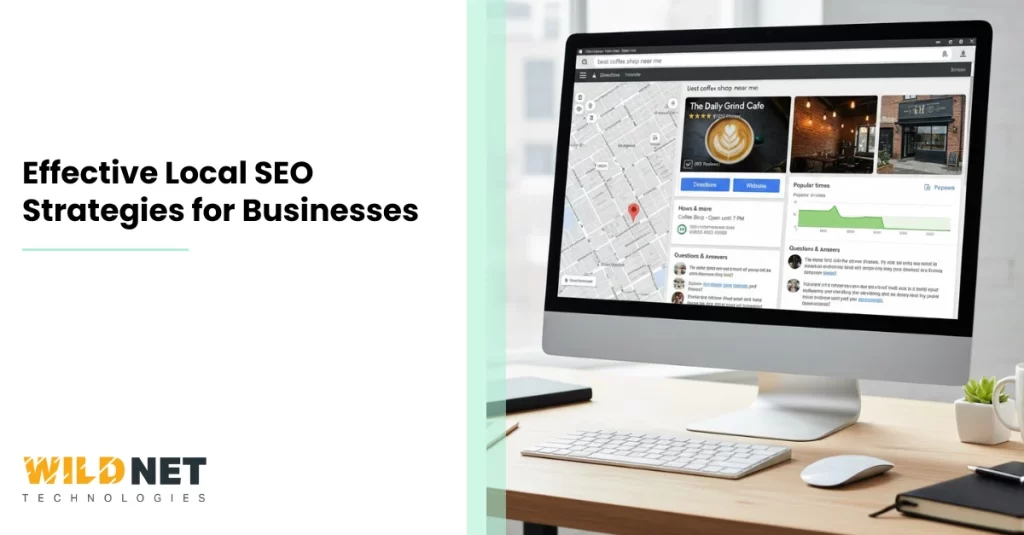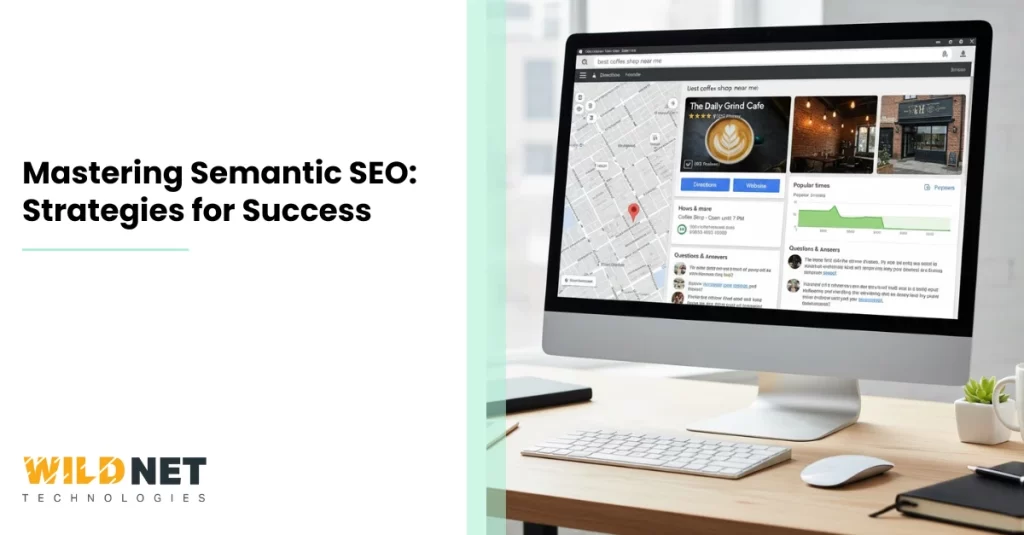In today’s digital age, local SEO is more important than ever. Businesses need to stand out in their local markets.
Local SEO strategies help businesses attract nearby customers. They improve online visibility and drive foot traffic.
But what exactly is local SEO? It’s optimizing your online presence for local search results.
This involves several key elements. Consistency is crucial when developing a local SEO strategy.
Your business’s name, address, and phone number (NAP) should be consistent everywhere. This builds trust with search engines.
Google My Business is a powerful tool for local SEO. A complete and updated profile can boost your visibility.
Customer reviews also play a significant role. Positive reviews can enhance your local search rankings.
Incorporating local keywords into your content is essential. It helps search engines understand your business’s relevance to local queries.
Building local backlinks from reputable sites can further improve your visibility. These links act as endorsements of your business.
Mobile optimization is another critical factor. Many local searches are conducted on mobile devices.
By following these strategies, businesses can effectively enhance their local SEO efforts. This guide will provide you with the tools and tips needed to succeed.
Understanding Local SEO: Why It Matters for Your Business
Local SEO is crucial for businesses focused on reaching nearby customers. It optimizes a business’s presence to be found in local search results, including searches with local intent, such as “near me” queries.
Local searches are particularly valuable. They often lead to higher conversion rates. Studies show that a significant percentage of local searches result in sales or visits within a day.
Businesses that ignore local SEO miss out on potential customers. They risk being overshadowed by competitors who optimize their regional presence.
A strong local SEO strategy positions your business prominently in search engine results. This is particularly relevant for Google’s local pack, the top result for many location-based queries.
Success with local SEO requires consistency. Your NAP (Name, Address, Phone number) must be uniform across all platforms, including your website, social media profiles, and online directories.
Inaccurate information can confuse customers and search engines. Ensure your business details are up-to-date. This will enhance your credibility and improve your search rankings.
Here’s why local SEO matters:
- Increases Visibility: Puts your business in front of potential local customers.
- Builds Community Engagement: Makes your business a part of the local community.
- Drives Foot Traffic: Converts online searches into in-store visits.
Investing in local SEO can transform your business by maximizing local reach. You will increase your online presence and connect better with nearby consumers. In today’s competitive environment, local SEO is no longer optional—it’s essential.
What Should Be Consistent When Developing a Local SEO Strategy?
Developing a successful local SEO strategy requires attention to detail. Consistency is the cornerstone of this process. Without it, your efforts may not yield the best results.
The most crucial aspect of consistency is your NAP data. Your business’s name, address, and phone number should be the same across all platforms. Any discrepancies can confuse both search engines and potential customers.
Google relies heavily on consistent NAP information to verify your business’s legitimacy. When developing your local SEO strategy, ensure every listing echoes the exact details.
Your business hours also need to be uniform. Changing hours on one platform but not others can frustrate customers. Ensure that your hours are synchronized everywhere your business is listed.
Your content should consistently use location-based keywords. Integrate these keywords naturally, whether on your website, blog posts, or social media. This improves your chances of appearing in local searches.
Consistency doesn’t stop at your textual information. It extends to your branding as well. Use the same logo and business description across different platforms. This builds trust and reinforces your business identity.
Here’s a quick checklist to maintain consistency:
- Verify NAP (Name, Address, Phone) across all platforms.
- Ensure uniform business hours and descriptions.
- Utilize consistent keywords throughout your content.
- Maintain branding, including logos and images, consistently.
Regular audits are essential. They help identify any discrepancies in your information. Ensuring everything is up-to-date and consistent enhances your local SEO effectiveness and improves your business’s visibility.
Inconsistent information can create doubt, leading potential customers to choose competitors. By prioritizing consistency, you set the foundation for a strong local SEO strategy that can significantly benefit your business in the long run.
Setting Up and Optimizing Your Google Business Profile
Google Business Profile is vital for local SEO. It helps your business appear prominently in local search results. Setting up a Google Business Profile is straightforward but requires attention.
Start by claiming your business on Google. This step is crucial. Go to Google My Business and verify your business ownership. Verification is essential for managing your profile.
Ensure your profile includes accurate and complete information, including your business name, address, and phone number. Remember, these details must match those on your website and other platforms.
Another important step is adding categories to your profile. Choose categories that best describe your business. This helps Google understand what your business offers and improves search relevance.
Fill out your profile’s services and product sections. Be detailed about what you offer. This will not only aid SEO but also inform potential customers.
Images play a significant role in optimization. Use high-quality photos that showcase your business. A picture is worth a thousand words, and in this case, it attracts clicks.
Here’s a concise checklist to optimize your Google Business Profile:
- Claim and verify your business.
- Provide consistent and complete information.
- Select appropriate categories and subcategories.
- Add detailed descriptions of services or products.
- Upload high-quality images of your business.
Encourage customers to leave reviews on your profile. Reviews enhance credibility and improve your local ranking. Respond to these reviews to show engagement.
Regularly update your profile. New promotions, events, or changes should be reflected in your Google Business Profile. Staying current boosts your business’s visibility and helps attract more local customers.
Conducting Local Keyword Research for Maximum Impact
Conducting effective local keyword research is key to success in local SEO. It helps you understand what your customers are searching for. This insight is crucial for optimizing your content and improving search visibility.
Start by thinking like a local customer. What phrases might they use when looking for your services? Consider the specific needs and terms unique to your area. This approach aids in identifying the right local keywords.
Use keyword research tools like Google Keyword Planner. These tools provide valuable data. They show search volumes and suggest related keywords, helping you pinpoint terms that have the potential to drive more traffic.
Focusing on long-tail keywords is often beneficial. These are more specific phrases that usually have less competition. They frequently convert better because they target precise intents.
Here’s a list of steps to refine your local keyword list:
- Identify local terms that align with your business.
- Use keyword research tools for insights and data.
- Focus on long-tail keywords for better conversion rates.
Incorporate local keywords naturally into your website content. Use them in titles, headings, and meta descriptions. It’s essential, though, to avoid keyword stuffing. This practice can harm your search engine rankings.
Explore competitors’ websites to see which keywords they target. Competitor analysis can offer valuable insights. It helps you understand market trends and discover untapped opportunities.
Here’s another checklist to keep your strategy on track:
- Analyze competitors’ keywords for additional ideas.
- Monitor keyword performance regularly.
- Adjust your strategy based on changing trends.
Create localized content that speaks directly to your audience’s needs and interests. This kind of content naturally incorporates local keywords and resonates with your community.
Finally, remember that keyword research is an ongoing process. Trends and search behaviors evolve, so periodic reviews and adjustments to your keyword strategy are necessary. This vigilance ensures you remain competitive in the local market.
Building and Managing Local Citations
Local citations are mentions of your business on various online platforms. These usually include your business’s name, address, and phone number (NAP). They are vital for local SEO as they enhance your business’s credibility.
Accuracy and consistency in your citations are crucial. Ensure that your NAP details are the same across all platforms. Discrepancies can confuse search engines and harm your rankings.
Listing your business in reputable local directories is a good starting point. Platforms like Yelp, Yellow Pages, and industry-specific sites are helpful. They allow companies to gain more visibility and drive local traffic.
Here are the steps to manage your local citations effectively:
- Audit existing citations for accuracy.
- Ensure consistency across all platforms.
- Use reputable directories to list your business.
Monitor these listings regularly. Regular checks prevent outdated or incorrect information from spreading. Updating your citations swiftly is essential, especially when your business information changes.
Consider using tools like Moz Local or BrightLocal. These tools can streamline the process of managing citations. They automate audits and updates, saving you time and effort.
Lastly, encourage customers to check and review these listings. Online reviews linked to citations can boost your profile, enhance trust, and improve your local search rankings.
Maintaining correct citations is an ongoing task. Continuously refining and overseeing these listings will strengthen your local SEO strategy. This focus on consistency and accuracy ensures that you retain a competitive edge in local search results.
The Power of Online Reviews and Reputation Management
Online reviews influence a business’s reputation and can sway potential customers’ decisions. Consumers often trust reviews as much as personal recommendations.
Encouraging customers to leave reviews is essential. Positive reviews can strengthen your online presence, boost your search rankings, and attract more local customers.
Responding to reviews—positive or negative—demonstrates engagement. It shows potential customers that you value feedback. Addressing issues raised in negative reviews can show responsibility and build trust.
Here’s how you can manage your online reputation effectively:
- Prompt customers to leave reviews.
- Respond to all reviews promptly and professionally.
- Monitor your reviews regularly for trends or issues.
Leverage different platforms for reviews. Google, Yelp, and Facebook are popular choices. Ensure your profiles on these sites are complete and optimized.
Use negative reviews as opportunities to improve your service. Every criticism offers insights into areas needing development. A prompt, courteous response can mitigate negative impressions.
Online reputation management is an ongoing process. Regularly assess reviews and take corrective action when needed. Your proactive approach can prevent reputational damage.
Finally, showcase positive reviews on your website. Share testimonials and success stories. This will not only enhance your credibility but also encourage potential customers to choose your services.
In sum, reviews and reputation management are crucial for local SEO. A positive reputation can drive more traffic and conversions. Listen to feedback and refine your customer approach.
On-Page SEO for Local Businesses: Key Elements
On-page SEO focuses on optimizing elements of your website. These elements influence how search engines rank your pages. They also affect how users interact with your content.
Start with your website’s title tags and meta descriptions. Use local keywords to attract nearby customers. These are the first things search engines and users see.
Headers (H1, H2, etc.) should be clear and keyword-rich. They help search engines and visitors navigate your site. Use these headings to organize content logically to improve readability.
Content quality is paramount. Provide informative and engaging content relevant to local interests. Incorporate local keywords naturally without stuffing them excessively.
Images on your site also require optimization. Use descriptive alt tags that include local keywords. This helps with image search rankings and improves accessibility.
Here are some key elements to focus on:
- Title Tags and Meta Descriptions: Incorporate relevant local keywords.
- Headers: Organize your content for ease of navigation.
- Content Quality: Ensure it’s relevant to local audiences.
- Image Tags: Use descriptive alt text with local keywords.
Don’t overlook the importance of internal linking. Guide users and search engines to other pages on your site. Link related content to keep visitors engaged longer.
Ensure your website is mobile-friendly. Many local searches are conducted on mobile devices, and a responsive design can enhance user experience and reduce bounce rates.
Lastly, update your content regularly. Fresh content signals to search engines that your site is active, which can help your site rank higher and keep your audience engaged.
On-page SEO requires ongoing attention. Regularly audit your site to identify areas for improvement. Keeping these elements optimized is crucial for local business success.
Creating Localized Content That Connects
It is essential to create content that resonates with your local audience. This content should speak directly to the community’s needs and interests.
Start by understanding your audience. Research local trends and topics that matter to them. This can provide insights into what content will have the most impact.
Engage your audience with stories that feature local events or people. Highlighting local success stories can build a strong connection and show that you understand and value the community.
Use local language and references. This can make your content more relatable, and it often makes readers feel like you’re speaking directly to them.
Incorporate locally relevant keywords naturally. These should align with your audience’s interests and language. Doing so helps improve your site’s visibility in local search results.
Here’s how to create content that connects:
- Research Local Interests: Know what your audience cares about.
- Highlight Local Stories: Make your content relatable.
- Use Local Language: Connect on a personal level.
- Incorporate Local Keywords: Enhance search visibility.
Remember to update your content regularly. Keeping it current ensures ongoing engagement, and fresh content also keeps your site relevant in search rankings.
Lastly, interact with your audience through comments and feedback. Responding promptly builds trust and a sense of community. Your audience will appreciate being heard and will be more likely to engage further.
Focusing on these strategies can help you create content that not only ranks well but also nurtures a loyal local audience.
Local Link Building: Strategies for Earning Local Backlinks
Local link building can significantly enhance your local search visibility. Backlinks from local sources signal to search engines that your business is relevant to the community.
Start by identifying potential local partners. Look for businesses, local blogs, or media outlets that share your target audience.
Reach out with a personalized email. Explain how a partnership could be mutually beneficial. Offer valuable content or propose a collaboration, such as a guest post.
Here are some effective strategies for building local backlinks:
- Engage with Local Blogs: Offer guest articles that provide value.
- Sponsor Local Events: Earn mentions in event promotions.
- Collaborate with Businesses: Build partnerships for cross-promotion.
- Join Local Directories: Get listed on reputable platforms.
Another approach is to host local events or workshops. This can attract coverage from local newspapers or bloggers who link to your site in their reports.
Joining local business associations can also be beneficial. These groups often offer member directories that include backlinks.
Consider offering scholarships or setting up charity collaborations. This will benefit your local community and encourage schools or nonprofits to link back to your site.
Lastly, track your backlinks to understand what’s working. Use tools like Google Analytics to monitor the effectiveness of your efforts.
Focusing on these strategies can help you build a solid foundation of local backlinks, which will bolster your local SEO and strengthen your community ties.
Leveraging Local Schema Markup and Structured Data
Implementing local schema markup is an advanced yet impactful local SEO strategy. Schema helps search engines understand your business’s location and offerings.
Including structured data on your website can enhance your search visibility. It helps search engines present your business information more effectively.
Use schema markup to highlight key details:
- Business Name and Address: Ensure these are accurate.
- Operating Hours: Make your availability clear.
- Contact Information: Help customers reach you easily.
- Local Events: Promote any hosted events.
Search engines can display this information directly in search results, often leading to a better click-through rate. Enhanced listings stand out, attracting more potential customers.
Ensure that your schema markup is correctly implemented. Use tools like Google’s Structured Data Testing Tool to check for errors.
Regularly update your structured data. Accurate and up-to-date information is essential for maintaining trust and relevance.
Leverage this advanced strategy to boost your local SEO efforts. Schematic markup can be a game-changer in your local search performance when implemented effectively.
Mobile Optimization and Voice Search for Local SEO
As mobile use rises, mobile optimization is critical for local SEO success. Users often search for local services on their phones, and a mobile-friendly website ensures a seamless user experience.
Optimize your website for fast loading times. Page speed greatly influences user retention and search rankings. Use responsive design to ensure accessibility across all devices.
Voice search is another growing trend to consider. Many users speak their searches, especially on mobile devices. Optimizing for voice means using natural language and local phrases.
Focus on long-tail keywords that mimic conversational speech. Consider how people ask questions about your industry. Here’s a quick checklist for mobile and voice optimization:
- Responsive Design: Ensure your site looks good on any screen size.
- Page Speed: Prioritize quick load times for mobile visitors.
- Natural Language Keywords: Tailor content for voice search queries.
Aligning your strategies with mobile and voice search habits helps you stay ahead in the competitive local SEO landscape. This focus not only aids in attracting local customers but also enhances overall user satisfaction.
Engaging with the Local Community Online and Offline
Building a strong presence in your local community involves more than just online tactics. Engaging with your online and offline audience can significantly boost your local SEO efforts. Being active in community events and forums cultivates trust and brand loyalty.
Online engagement begins with social media. Join local groups on platforms like Facebook or Nextdoor. Share content that resonates with local interests or events. Respond promptly to comments and messages to show you value customer interaction.
Offline, consider sponsoring or attending community events. This boosts your visibility and positions your business as an integral part of the community. Supporting local charities or hosting events also strengthens community bonds.
Here are a few ideas to enhance local engagement:
- Join Local Forums: Participate in online discussions relevant to your industry.
- Sponsor Events: Support local activities to increase brand recognition.
- Social Media Engagement: Actively reply to and engage with local followers.
By actively engaging with local audiences, your business builds stronger community ties. This integrated approach fosters loyalty and enhances your local business SEO strategy.
Tracking, Measuring, and Improving Your Local SEO Strategy
To succeed in local SEO, businesses must regularly track and measure their efforts. Understanding what’s working and what needs adjustment helps you stay competitive. Use tools like Google Analytics to monitor website traffic from local searchers.
Additionally, Google Search Console provides insights into your site’s appearance in search results. Analyze which local keywords are driving traffic and optimize accordingly. Being aware of your website’s performance helps pinpoint areas for improvement.
Creating regular reports will allow you to track trends over time. This will provide a clearer picture of your progress and highlight effective tactics. Adapting your strategy in response to findings is crucial for growth.
Here’s how you can enhance your local SEO:
- Set Clear Goals: Define what success looks like for your local SEO.
- Regularly Review Data: Frequently analyze data from SEO tools.
- Adjust Strategies: Implement changes based on insights from analytics.
Improvement is continuous. Regular audits ensure your local SEO strategy remains relevant and practical. By focusing on data-driven decisions, you can refine your approach and maintain a strong online presence in local search results.
Advanced Local SEO Tips and Trends for 2024 and Beyond
Staying ahead of the competition requires embracing the latest SEO trends. As we move into 2024, several advanced tactics can help.
Firstly, focus on creating hyper-localized content. This type of content targets specific neighborhoods or streets, making it highly relevant to your audience. Being relatable on a micro-level can significantly enhance your local reach.
Secondly, consider the rise of AI and machine learning in SEO. These technologies can provide insights into search patterns and preferences, allowing you to tailor strategies effectively. Keeping abreast of technological advancements ensures your strategy remains cutting-edge.
Additionally, video content is gaining traction in local SEO. Videos allow businesses to present their community engagement, products, and services engagingly. As they are easily shareable, videos can increase your visibility and reach.
Key trends for 2024 include:
- Hyper-Localized Content: Focus on particular areas.
- AI and Machine Learning: Use data insights to optimize strategies.
- Video Content: Capture and engage your audience visually.
By integrating these advanced strategies, your business can enjoy improved visibility and remain competitive. Adapt to these trends early to future-proof your local SEO efforts and stay ahead in the coming years.
Common Local SEO Mistakes to Avoid
Mistakes in local SEO can hinder your business’s growth. Recognizing and avoiding these errors is key. One common mistake is ignoring the importance of NAP consistency. NAP stands for Name, Address, and Phone number. Discrepancies in this information across platforms can confuse both customers and search engines.
Another frequent oversight is neglecting Google Business Profile management. An incomplete or outdated profile loses potential leads. Regular updates and accurate information are vital for maintaining visibility.
Also, overlooking mobile optimization can cost potential customers. Most local searches occur on mobile devices, so a poor mobile experience can lead to high bounce rates. Ensure your website is mobile-friendly and loads quickly.
Common mistakes include:
- Inconsistent NAP Information: Ensure consistency across platforms.
- Neglecting Google Business Profile: Keep it updated for better visibility.
- Ignoring Mobile Optimization: Prioritize a seamless mobile experience.
Avoiding these local SEO pitfalls ensures your strategy remains effective. You can enhance your local presence by keeping NAP details consistent, managing your Google profile, and optimizing for mobile. Addressing these issues promptly can lead to significant improvements in local search performance.
Conclusion: Building a Sustainable Local Business SEO Strategy
Crafting a robust local SEO strategy requires constant attention. This isn’t a one-time task but an ongoing process. Businesses must stay adaptable to maintain visibility. The digital landscape evolves, and so should your strategies.
Sustainability in local SEO hinges on consistency and adaptability. Regular audits are crucial to understanding what works and what needs to change. Tracking industry trends and consumer behaviors helps maintain relevance.
Focus on every detail. From managing Google Business Profiles to local keyword optimization, every action counts. A sustainable strategy encompasses a holistic approach. Online and offline Engagement with local communities enhances credibility and builds trust.
Key aspects to maintain include:
- Regular Strategy Audits: Identify areas for improvement.
- Consumer Engagement: Foster strong local relationships.
- Consistency in Efforts: Ensure ongoing local SEO initiatives.
Businesses can create a sustainable local SEO plan by focusing on these elements. The goal is to stay ahead of competitors while connecting deeply with the local audience. Building a sustainable strategy ensures long-term success in local search results.
By implementing strategies like these, businesses can unlock new growth opportunities and stay ahead of competitors in the ever-evolving digital landscape. If you’re ready to take your online presence to the next level, our expert team is here to help. As a trusted SEO services and digital marketing company, we specialize in driving measurable results, improving rankings, and maximizing ROI—partner with us today to transform your visibility and turn search traffic into lasting business success.
1. What is Local SEO?
Local SEO is the practice of optimizing your online presence to attract more business from local searches on Google and other search engines.
2. Why is Local SEO important for small businesses?
It helps small businesses appear in “near me” and location-based searches, making it easier for local customers to find and choose them.
3. What are the key factors that affect Local SEO rankings?
Google Business Profile optimization, local citations, reviews, mobile-friendliness, and location-specific keywords are major ranking factors.
4. How long does it take to see results from Local SEO strategies?
Businesses typically see improvements in 2–3 months, depending on competition and consistency in optimization.
5. Can I manage Local SEO myself, or do I need professional help?
Basic steps like setting up Google Business Profile can be done yourself, but for long-term growth and stronger results, working with an SEO expert is highly recommended.
Read More






